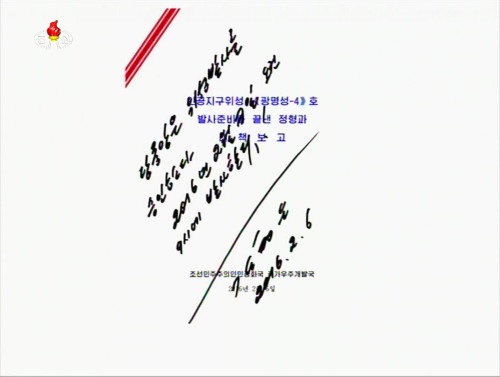I had a busy night last night. For those of you not on Twitter (or who sleep), here’s a quick rundown of events.
North Korea launched a rocket from its Sohae Satellite Launching Station just after 9:00am on 7 February local time. North Korea notified the International Maritime Organization of its projected splashdown zones and later revised it to a window of 7-14 February.
38 North caught fueling activities with satellite imagery, but it has become difficult to assess launch times with the new covered rail and support facilities at the pad. CNS made the following 3D visualization for NTI in October. It shows many of the improvements to the pad, although North Korea added more fueling bunkers, as well as facilities to the engine test stand in recent weeks.
North Korea made a formal announcement of its success at 12:00 local time, and for the first time in my recollection opened live YouTube and Ustream channels. The quality was terrible, so as usual I am very grateful to Martyn Williams’ link. He posted video and audio, for posterity.
North Korea's English-language radio service on the Kwangmyongsong-4 satellite launch: https://t.co/3bYVPoEekP
— Martyn Williams (@martyn_williams) February 7, 2016
During the announcement they flashed and image of Kim Jong Un signing the order to launch.
Kim Jong Un signing the order for launch of Kwangmyongsong-4 satellite. #DPRK pic.twitter.com/gNAK1L3gX3
— Melissa Hanham (@mhanham) February 7, 2016
KCTV showed a close up of the Report on preparations, entitled “인공지구위성 ‘광명성-4호’ 발사 준비를 끝낸 정형과 대책 보고 [Official report on completed preparations for Gwangmyeongsong-4 satellite launch].”

On it, Kim Jong Un has written: “The Central Party approves the satellite launch. The launch will take place on 2016.2.7 at 9 AM / KIM JONG UN 2016.2.6,” which was not very Juche calendar of him. Hat tip to my research assistant Bo Kim on the translation.
KCNA also made an official announcement calling the rocket “Kwangmyongsong.” Just like the satellite? Not very creative people!
Here is the KCNA statement on the #NorthKorea rocket launch. pic.twitter.com/DuklBDm7Aq
— Jeffrey Lewis (@ArmsControlWonk) February 7, 2016
My colleagues and I grabbed any images of the rocket we could find. Initial impressions are that it is extremely similar to the Unha-3 rocket.
So far they look pretty similar, but will get it into Photoshop to make more accurate measurements on Monday. pic.twitter.com/aEOq8hqFkx
— Melissa Hanham (@mhanham) February 7, 2016
This is a SketchUp overlay of the 2012 and 2016 launch vehicles. Once the high resolution photos come out, we’ll do a more careful analysis correcting for the camera angle. This is also just an assessment of the outside of the rocket. We don’t know how much tinkering went on inside, but the similar splash down zones in 2012 and 2016 makes me think — not too much.
Kwangmyongsong and Unha-3 overlaid. Perfect fit. #DPRK h/t anonymous @miis student. pic.twitter.com/9HnYcL0asv
— Melissa Hanham (@mhanham) February 7, 2016
The satellite and 3rd stage are now in orbit. No transmission yet that I know of.
US is tracking KMS-4 – TLEs are out showing 41332 (2016-009A) in a 466 x 500 km orbit
— Jonathan McDowell (@planet4589) February 7, 2016
You can follow object 41332 aka KMS-4 at www.space-track.org. People are already posting visualizations.
KMS 4 orbit and current KMS 3-2 orbit: pic.twitter.com/TS1ZWzwH5G
— Dr Marco Langbroek (@Marco_Langbroek) February 7, 2016
Going forward, CNS will do some image and video analysis once it becomes available. You can see our currently available 3D models and videos for Sohae and the Unha-3 here.
You can also expect the US and South Korea to attempt to recover the wreckage of the first and second stages of the rocket. In 2014, the UN Panel of Experts on North Korea documented many components of foreign origin.
Can't wait to see the wreckage. They found US, Chinese, ROK parts in the Unha-3 from 2012. https://t.co/5FBYtSTNoQ pic.twitter.com/9HMxnhhXTe
— Melissa Hanham (@mhanham) February 7, 2016
You can also expect a pretty vigorous debate on the next round of sanctions and THAAD. I’m getting out the popcorn!

I noted that the orbit given in the DPRK radio bulletin you link, is different from what western military tracking (JSpOC through Space-Track) gives so far.
The DPRK bulletin gives a perigee at “494.6 km. JSpOC data so far put it much lower, at 465 km.
This could perhaps be initial error in the JSpOC orbit determinations (the first few orbits never are fully reliable), but the magnitude of the difference is such that I doubt that.
Assuming that the values in the DPRK radio announcement are not from actual North-Korean tracking, but rather is the pre-launch desired orbit: then perhaps this discrepancy could indicate that the satellite ended up in a lower apogee orbit than intended.
But let’s wait with a final verdict until more tracking data are in.
Perigee, not apogee, sorry
Excellent work as always, Melissa. But I think you may be waiting a long while for that wreckage – South Korea is reporting that one of their Aegis destroyers tracked the first stage on the way down and recorded it breaking up into ~270 pieces. Quite possibly they don’t want curious wonks poking around inside their rocket this time 🙂
As for the orbit, 500 km circular and 97.4 degrees inclination would be a sun-synchronous orbit ideal for the Earth observation satellite North Korea says it launched; 501 x 466 km at 97.5 degrees would be slightly asynchronous (though still good enough to see if the thing works and conduct some limited operations). So I’m guessing the DPRK announcement was mostly aspirational and the JSpOC numbers are actual.